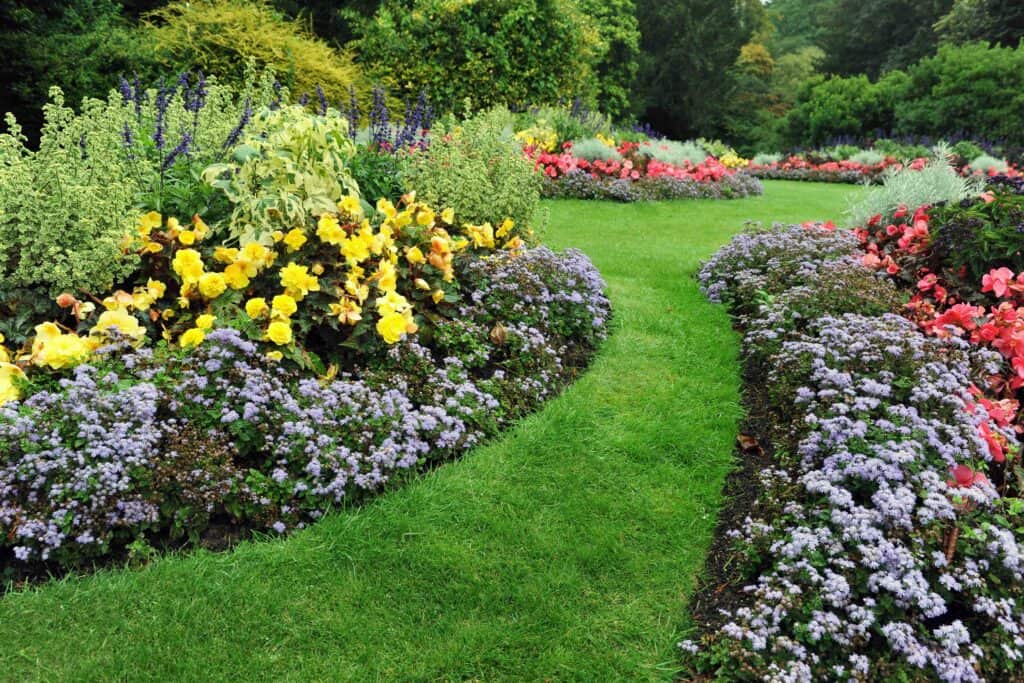There are all sorts of ways to coordinate the colors in your garden with the colors you choose for both the exterior and interior of your house. You can use colors to echo, or repeat, from house to garden, or to harmonize with one another. Or you can juxtapose colors that contrast and intensify when you place them in proximity to each other. You can approach color choices for your garden in a number of different ways. You can, for instance, design your garden so that some of its colors echo colors from your house. The colors in your garden can harmonize with the colors of the house, or the garden can contrast with the house. Either of these approaches can work if you take some time to think about your color possibilities.

There are four basic ways to work with color to build color schemes in the garden. You can rely on a single flower color contrasted against foliage, you can combine harmonious or analogous colors, or contrasting or complementary colors, or you can plant in an assortment of mixed colors.
The simplest color scheme of all is built on a single color, perhaps expressed in several different shades and tints, and perhaps with a small amount of a second color added as an accent. Monochromatic gardens can be quite soothing to the eye, and their simplicity can work extremely well in a formal setting. You might like a garden of all white flowers, or red, or yellow. Or you could combine several shades of pink.
Harmonious, or analogous, colors blend smoothly with one another. Examples of harmonious colors schemes are red, orange and gold; or blue, purple and pink. Harmonious color schemes are often quiet and subtle, such as a blend of pastel shades of pink, rose and lilac petunias. But they can also be surprisingly dramatic, as in a bed of orange and yellow cosmos and marigolds, red salvia, golden achillea and Red King Humbert canna (red flowers and purple-red leaves). An easy way to get a harmonious combination of colors is to plant several varieties of one type of flower. You might want to plant several kinds of celosia, for example, or astilbe or daylilies.
Contrasting colors are farther apart on a color wheel, and placing them next to each other emphasizes their different qualities. Complementary colors contrast more intensely than any other juxtaposition of colors. Examples include blue and orange, purple and yellow, and red and green. If you want to plant a garden of complementary colors you will probably find the most pleasing results by planting the softer of the two colors over a large portion of the garden and using the brighter color sparingly, as an accent.
In a multicolored, or polychromatic, garden, the variety of colors included depends entirely on your preference. Multicolored gardens can be blindingly brilliant if all strong colors are used; they can be cheerful and festive if you mix pastels with a few bright tones; or they can be surprisingly subtle when soft, pale colors are used. A polychromatic garden generally works best when one color is dominant to bring a sense of cohesiveness to the overall scheme. To get the best effect from a multicolored garden, surround it with lots of green to provide some visual relief. Set your flowers of many colors in front of evergreen shrubs or a hedge, or in a bed in the middle of a lawn.
However you approach the color scheme of your garden, be sure to take time to enjoy the flowers!









![Drawing inspiration from the Greek Revival style of architecture, 7 Somers Place was developed by Sag Harbor master builder, Robert Tortora. The gracious living room with mantled masonry fireplace and elevated ceilings flows to the spacious dining room and custom light-filled kitchen. Represented by @thechrisritchey and Kim Hovey of @compass. [link in bio]](https://hamptonsrealestateshowcase.com/wp-content/uploads/sb-instagram-feed-images/488012730_18501545716030135_2576407923807360973_nfull.webp)
![Elegance and intelligence abound at this waterfront masterpiece with 8,065± sq ft, 7 bedrooms and 8.5 baths. 101 Jessup Lane boasts a sweeping double stairway entry hallway, 7 romantic fireplaces, a large gathering room, formal dining room, billiard room, and exercise room with sauna. Represented by @rydbergkent of @douglaselliman. [link in bio]](https://hamptonsrealestateshowcase.com/wp-content/uploads/sb-instagram-feed-images/486626595_18501344173030135_6414454892538890571_nfull.webp)
![Discover fabulous floral finds and nature-inspired treasures to bring beauty and charm to your life. Whether you’re adding a touch of nature to your home or finding the perfect gift, these blooming delights are sure to brighten your day! [link in bio]](https://hamptonsrealestateshowcase.com/wp-content/uploads/sb-instagram-feed-images/487711988_18500839267030135_4881948075500906108_nfull.webp)
![Spring, of course, leads inexorably into another summer season here in the Hamptons. According to agents we spoke to, demand is quite strong this year for rentals. A quality medium-priced property, well presented with amenities, is eagerly sought-after. Publicly listed rentals range from a high of $2.5 million, Memorial Day to Labor Day, on Cobb Lane in Water Mill, with quite a few more $1 million plus rentals than usual. [link in bio]](https://hamptonsrealestateshowcase.com/wp-content/uploads/sb-instagram-feed-images/486541532_18500603206030135_1827695170316201968_nfull.webp)
![Perched atop the dunes at Louse Point sits a picturesque house, perfect for enjoying all seasons that East Hampton has to offer. Situated on three quarters of an acre with almost 360 degree views of Gardiner’s Bay and Accabonac Harbor, 86 & 88 Louse Point are truly unique. Represented by @petrieteam of @compass. [link in bio]](https://hamptonsrealestateshowcase.com/wp-content/uploads/sb-instagram-feed-images/486615712_18500408650030135_1498783920053065135_nfull.webp)
![Set to be completed this year, this extraordinary property spans 2.5± acres of cleared land and showcases over 12,125± sq. ft. of architectural sophistication and refined design. With 9 bedrooms, 11 full baths, and 2 half baths, 261 Millstone Road offers an exceptional blend of spaces for both relaxation and entertainment. Represented by @susan.breitenbach of @thecorcorangroup. [link in bio]](https://hamptonsrealestateshowcase.com/wp-content/uploads/sb-instagram-feed-images/486599655_18500185618030135_8926656954621895711_nfull.webp)

![If you are a buyer searching for an exclusive, brand-new mid or high-rise residence in Naples, Florida, Mystique 601 cannot be missed. Expansive floor-to-ceiling windows invite abundant natural light, seamlessly blending indoor and outdoor living with breathtaking Gulf views. Represented by Mark Riley of @luxepropertiesmia. [link in bio]](https://hamptonsrealestateshowcase.com/wp-content/uploads/sb-instagram-feed-images/486018213_18499791688030135_1711217068426589475_nfull.webp)
